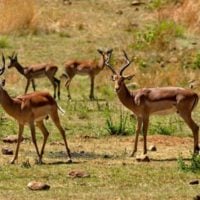Deadline: 4-Aug-23
The Wild Animal Initiative’s Seed Grants Program is providing small amounts of funding to facilitate projects that will test promising new techniques or approaches, incorporate welfare assessments into ecological research and management, or adapt animal welfare science approaches for wild contexts.
Seed Grants are ideal for early-career scientists or more established principal investigators who have no previous experience with wild animal welfare research.
Seed Grants empower wild animal welfare researchers to explore topics neglected by other funders. They support research that advances understanding of the fundamental concepts, novel methods, and preliminary interventions that will most rapidly accelerate progress in the field.
The scope of wildlife research has largely been limited to the harms humans cause. Therefore, much uncertainty remains about what animals’ lives are like in the wild, and what humans could do to help responsibly. The diversity of animal species and the complexity of ecosystem interactions require a wider range of research expertise than any one research group might have.
Themes
- Theme 1: Wild fish welfare
- Understanding the welfare of the most numerous and neglected vertebrates.
- Fishes have different neurological structures from terrestrial vertebrates, and as such might experience the world very differently. This has led some to suggest that fish are incapable of experiencing pain, and thus to claim that they are not sentient.
- But research exploring fish cognition and behavior clearly demonstrates that at least a significant proportion of fish species experience pain and are consciously aware of their environment.
- The aquatic environment and small size of many fishes also makes them challenging to study and monitor on an individual level in the wild. Fishes have major physiological and behavioral differences from terrestrial vertebrates whose welfare is more often considered, so the applicability of welfare indicators designed for those species is limited. But because fishes are extremely numerous and diverse, they are of great importance to Wild Animal Initiative’s goal of understanding and ultimately improving the welfare of as many wild animals as possible.
- Wild Animal Initiative invites applicants to propose projects that explore ways to measure, monitor, and evaluate the welfare of wild fishes. They particularly encourage applicants to pursue studies that seek to go beyond lab experiments and hatchery welfare to obtain an understanding of wild fish welfare in situ.
- Examples
- Suitable research avenues that could be explored under this theme include, but are not limited to:
- Developing novel techniques for measuring and monitoring the affective states of fish in their wild environments, and/or piloting such techniques in the wild.
- Applying or validating welfare indicators developed for farmed fishes for use with non-captive fishes in their wild environments.
- Developing ways to recognize, evaluate, and quantify specifically positive-valenced experiences in wild fishes.
- Application of acoustic technology for monitoring changes in wild fish welfare at a population or community scale.
- Use or development of assays, such as hormonal EIAs, that assists with real-time welfare monitoring.
- Comparing the welfare of wild-born vs. stocked (captive-bred) fishes in wild environments.
- Determining the welfare implications of networked effects of fishing, such as trophic interactions and density-dependent (compensatory) demographic responses.
- Characterizing the direct and indirect impacts of near-term interventions that could benefit large numbers of individual wild fish beyond fisheries.
- Suitable research avenues that could be explored under this theme include, but are not limited to:
- Understanding the welfare of the most numerous and neglected vertebrates.
- Theme 2: Near-term welfare interventions
- Identifying ways to improve the welfare of a large number of wild animals within the next decade
- They are interested in near-term interventions that are designed to improve the welfare of wild animals and could potentially be implemented within the next 5-10 years. While these interventions must address current welfare threats, these may include perennial challenges animals face, such as starvation, disease, and predation.
- Before it will be possible to implement large-scale interventions with long-term objectives, they must first be able to anticipate and manage indirect impacts, which require a better understanding of ecosystem dynamics and wild animal welfare.
- Therefore, near-term interventions should be highly reversible, with the targeted biological or ecological parameters able to regress to their pre-intervention state within a few years, or a generation, of the intervention coming to an end. In practice, this means that until indirect effects have been thoroughly investigated; near-term interventions should focus on affecting the welfare of directly treated animals and/or their immediate offspring.
- Wild Animal Initiative will not be funding implementation of near-term interventions as part of this call for proposals. Instead, they are interested in supporting projects those pilot or model potential near-term interventions to test their viability or underlying concepts. They will also support projects that aim to evaluate the welfare implications of interventions that are already being implemented for non-welfare reasons (e.g. conservation or human health), but for which the welfare implications have not yet been examined.
- Examples
- Suitable interventions that could be explored under this theme include, but are not limited to:
- Wildlife fertility control/contraception
- Supplemental feeding
- Immunization or treatment of infectious disease
- Wildlife corridors
- Reducing impacts of anthropogenic light/noise pollution
- Predator deterrence
- Suitable interventions that could be explored under this theme include, but are not limited to:
- Identifying ways to improve the welfare of a large number of wild animals within the next decade
Funding Information
- Grant size – $2,000 — $30,000 USD total.
- Duration: Up to 2 years
Eligibility Criteria
- Seed Grants are available to anyone, but they are especially interested in supporting early career researchers (postdocs and PhD students) pursuing a long-term research career in wild animal welfare, or established researchers who seek to expand their research portfolio to include wild animal welfare.
- Eligible projects include those that are standalone, or those that add a wild animal welfare component to an existing non-Wild Animal Initiative funded project to broaden its scope.
- Projects must be led by a principal investigator who is affiliated with a university or other research institution (e.g. a government agency).
- Projects must be led by or include collaborators who are residents of all countries where field work will take place. If a project is managed by an NGO, that NGO must be registered in the country where field work will take place.
- They prioritize funding for direct research costs (e.g. supplies, materials), though they do fund other expense areas (e.g. stipends, salaries, capital equipment) if they are fully justified relative to the project goals.
Ineligible
- They do not provide funding for indirect costs or institutional overhead.
- They are unable to sponsor visas, so they generally cannot fund work that would be carried out in the United States by a non-US resident.
- They are unable to fund research carried out in nations subject to sanctions by the United States (e.g. Iran, North Korea, Russia) or researchers who are residents of those nations.
- They generally do not fund more than one active project being led by the same Principal Investigator at the same time.
- Projects that do not characterize the subjective experience (welfare) of animals or do not treat it as their objective.
- Projects focused exclusively on wildlife conservation.
For more information, visit Wild Animal Initiative.









































